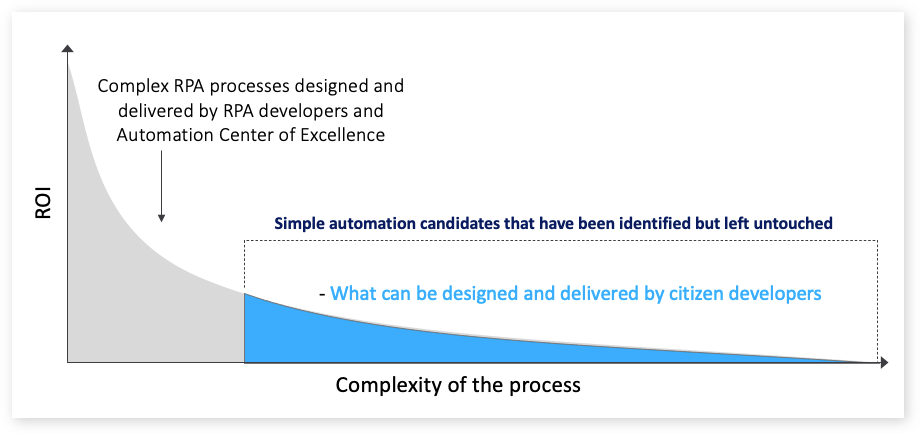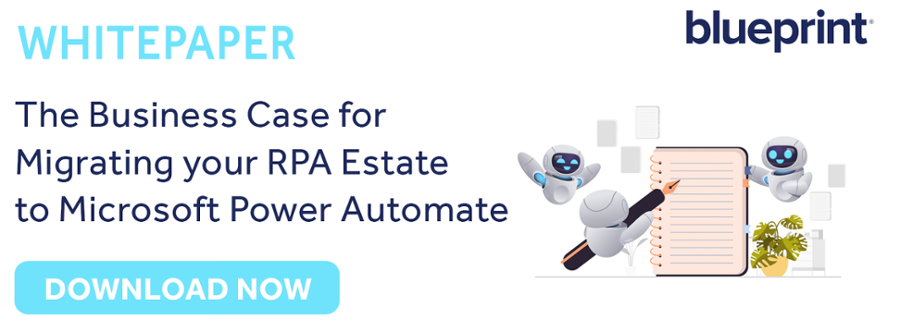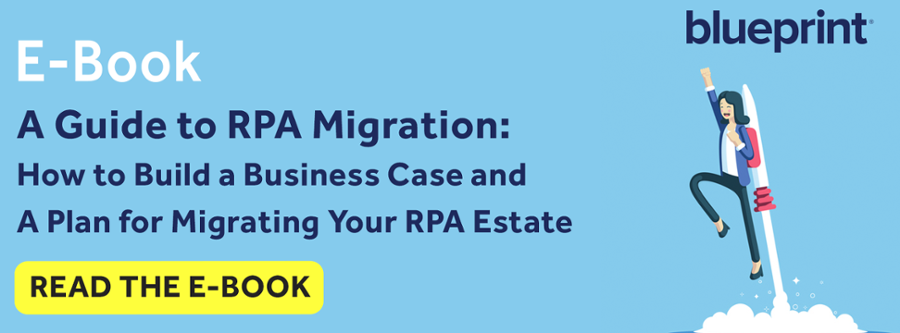What is RPA Migration? Everything You Need to Know
RPA (robotic process automation) migrations are picking up steam. Organizations are quickly growing frustrated with the legacy RPA tools they started their automation journeys on.
A high level of technical complexity and aggressively rising prices are motivating more and more businesses to consider other options in the marketplace, such as the much more user-friendly and cost-effective Microsoft Power Automate.
This article provides you with everything you need to know about RPA migrations including what it is, why it can be challenging, knowing when it’s right to migrate, and how you can do it.
What is RPA Migration?
RPA migration is where an organization moves their RPA estate (that is, all the automated processes they currently have in production) from one RPA platform into another. It all sounds rather simple, but it can actually be very challenging depending on how you choose to go about it.
Without the right technology, RPA migrations can be very tricky.
What are the Challenges with RPA Migrations?
RPA migrations can be very challenging because RPA platforms specify automated processes differently. An automation in one tool won’t work in another RPA tool, requiring automated processes to be rebuilt from scratch so they can work in the destination platform.
Historically, this was done manually which was very expensive and labor-intensive. Each automation had to be investigated, understood, and then re-coded or re-built for the new destination RPA platform by a highly skilled technical resource. It was also considered a high-risk activity, as potential human error could cause downtime and outages.
This is no longer the case. There are now purpose-built technologies that dramatically reduce the manual effort and extensive timelines for RPA migrations because they do the majority of the conversion and mapping work for you.
Six Reasons Organizations are Choosing RPA Migration
Even with the previous challenges surrounding RPA migration, organizations are still very eager to migrate their RPA estates to new platforms.
In this blog, we’ve written extensively on what’s motivating them which you can read here and here, but here’s a summary of what’s driving companies to switch tools:
#1 - Reduce costs
Legacy RPA tools are inherently expensive and some of them are even aggressively increasing their prices. Organizations’ total cost of ownership (TCO) for automation has inflated rapidly.
With incredibly cost-effective options on the market like Microsoft Power Automate, organizations want to reduce their automation OpEx (operational expense) and take advantage of much better pricing models to bring their TCO down.
#2 - Decrease complexity
Legacy RPA tools are also very complex. Highly skilled technical employees are needed to essentially code each automated process into production.
Next-generation intelligent automation platforms are breaking that mould. They’re providing intuitive drag-and-drop canvasses to build automations that enable scale and citizen development where the average business user can design and develop automations.
#3 - Achieve scale and realize greater returns
Because legacy RPA platforms are so complex, there is an over-reliance on IT to develop and deploy automated processes. The result is long backlogs of work and the inability to scale and realize better ROI.
By decreasing complexity through simplified RPA platforms, citizen developers, average business users empowered with easy-to-use automation tools, can tackle the long-tail of automation opportunities and accelerate the application of RPA across the business.

#4 - Leverage better capabilities and features
Legacy RPA platforms have stagnated in terms of product development. Relatively new offerings like Microsoft Power Automate deliver richer feature sets and capabilities that can harness the true value and benefits of automation like increased efficiency and higher quality process output.
# 5 - Leverage better compatibility with enterprise architecture
Every organization now has a deep and varied tech stack. The RPA platforms they started their automation journeys on don’t always play nice with the rest of the tools in their enterprise architecture.
That’s why Microsoft Power Automate is attracting so much attention as the destination tool for companies that want to migrate their RPA estates. Microsoft Power Automate enables seamless automation with the rest of the Microsoft ecosystem of products like Azure, Office 365, etc. There are also a multitude of connecters to easily automate processes that interact with third-party business applications.
# 6 - Expand automation beyond just RPA
Organizations also want to migrate their RPA estates to new automation platforms to enable their lo-code/no-code digital strategies. That's one of the main reasons Microsoft Power Automate is attracting so much attention in the RPA space.
The Microsoft Power Platform (where Power Automate is one of several powerful solutions) enables organizations to expand automation beyond just RPA as part of their digital transformation strategy. Applications can be easily built by the average business user with Power Apps. Conversational AI experiences and chatbots can be built with Power Virtual Agents. Even engaging websites can be designed with Power Pages, and all data can be tied together and centralized with Power BI.
When do You Know it’s Time for RPA Migration?
Knowing when it’s time to migrate your RPA estate to a better automation platform is really a question only you and your other automation stakeholders can answer. There are, however, a few signs that can provide a clearer indication that the time for RPA migration has come.
Some warning signs to look out for include:
- Are you underwhelmed with the returns and ROI your automation practice is delivering on your current legacy RPA tool?
- Have your automation costs gotten out of hand?
- Is your current RPA vendor increasing their prices and licensing fees?
- Are you having difficulty scaling your automation practice across the business?
- Are you relying too heavily on technical resources to develop and deliver automated processes?
- Is your current legacy RPA tool too complex?
- Could you benefit from having business users design and deliver automations with a simplified and intuitive platform?
- Are you already using an array of Microsoft products?
Answering those brief and simple questions will give you a better indication of whether it’s time for you to actively explore migrating your RPA estate.
Once you’ve made the decision to switch RPA providers, we strongly recommend that you perform a feasibility assessment to understand:
- How much effort would be involved in migrating your RPA estate to another automation platform
- How much of your RPA estate is already compatible with your destination tool of choice
- Areas for optimization or retirement opportunities to further decrease your total cost of ownership and possible maintenance and support issues in the future.
One of the first steps in migrating our customers with Blueprint’s RPA Migration solution is precisely this kind of assessment for the reasons listed above.
How Should You Perform Your RPA Migration?
Traditionally, the biggest deterrent to switching RPA vendors was that they had to be completed manually. Regardless of how frustrated an organization was with their legacy RPA tool, the cost and effort involved with migrating RPA estates was too large to justify in many cases.
Purpose-built solutions, like Blueprint’s RPA Migration solution that automatically convert your RPA estate and do most of the work for you is the much more cost-effective and faster option.
Before selecting an RPA migration solution, you’ll want to build a solid business case to gain executive sponsorship and prove out the ROI you will realize by migrating your automation estate.
Beyond building a business case and selecting a solution to facilitate your switch, you will also want to retain the services of a global service integrator (GSI) who will accelerate and take care of the more technical details such as testing and deployment in your destination RPA tool.
For an RPA migration playbook that enables you to plan your switch strategically and efficiently, download our recent E-book: A Guide to RPA Migration for all the insight and guidance you need to get this initiative off the ground successfully and effectively.
Share this
Recent Stories

5 Takeaways From Our Recent RPA Migration Panel: Who Moved My Bots?

Automation Year in Review 2023




